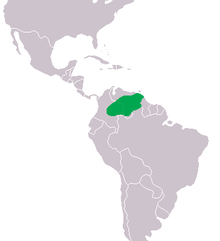Orinoco crocodile
| Orinoco crocodile | ||||||||||||
|---|---|---|---|---|---|---|---|---|---|---|---|---|

Orinoco crocodile ( Crocodylus intermedius ) |
||||||||||||
| Systematics | ||||||||||||
|
||||||||||||
| Scientific name | ||||||||||||
| Crocodylus intermedius | ||||||||||||
| Graves , 1819 |
The Orinoco crocodile ( Crocodylus intermedius ) is a species of the real crocodiles (Crocodylidae). The species is critically endangered according to the IUCN Red List .
features
The Orinoco crocodile is a large species of crocodile and can likely reach a body length of six meters or more. It is light to olive brown in color and has a slightly darker pattern of transverse bands on the tail. It differs from the American crocodile ( Crocodylus acutus ), which appears sympatric with it in some areas , mainly in the more pointed and narrow snout and the symmetrically arranged scales on the back armor .
distribution
The habitat of the Orinoco crocodile is presumably mainly in the area of the larger rivers in the freshwater area of the Orinoco in Colombia and Venezuela . More precise information is made difficult by the strong risk of confusion with the American crocodile, which occurs mainly in the mouth of the river.
Way of life
The Orinoco crocodile probably feeds primarily on fish, which it can grab and hold very well with its narrow snout. However, it also catches amphibians , other reptiles , birds and mammals . There are no verified reports that these crocodiles attacked humans, but early travelers did report them.
The breeding behavior of the animals is largely unknown, like all other American crocodiles , it is a pit tank .
Danger
The Orinoco crocodile is listed as critically endangered on the IUCN's Red List of Endangered Species (as of 2017). Especially in the first half of the 20th century, the species was heavily hunted for the trade in crocodile skins, which led to a drastic decline in the population. Today the species is mainly threatened by habitat loss, killing to obtain meat and eggs for food and the trade in young animals. The population is estimated at 90-254 adults, which are split into 34 subpopulations. The stocks are likely to continue to decline.
literature
- Charles A. Ross (Ed.): Crocodiles and Alligators - Development, Biology and Distribution , Orbis Verlag Niedernhausen 2002
- Joachim Brock: Crocodiles - A life with armored lizards , Natur und Tier Verlag Münster 1998
Web links
- Crocodylus intermedius in the endangered Red List species the IUCN 2006. Posted by: Crocodile Specialist Group, 1996. Retrieved on 9 May, 2006.
- Crocodylus intermedius in The Reptile Database
Individual evidence
- ↑ Balaguera-Reina, SA, Espinosa-Blanco, A., Antelo, R., Morales-Betancourt, M. & Seijas, A .: IUCN Red List of Threatened Species: Orinoco Crocodile. October 19, 2017, accessed April 7, 2020 .
- ↑ Crocodilian Species - Orinoco Crocodile (Crocodylus intermedius). Retrieved April 7, 2020 .
